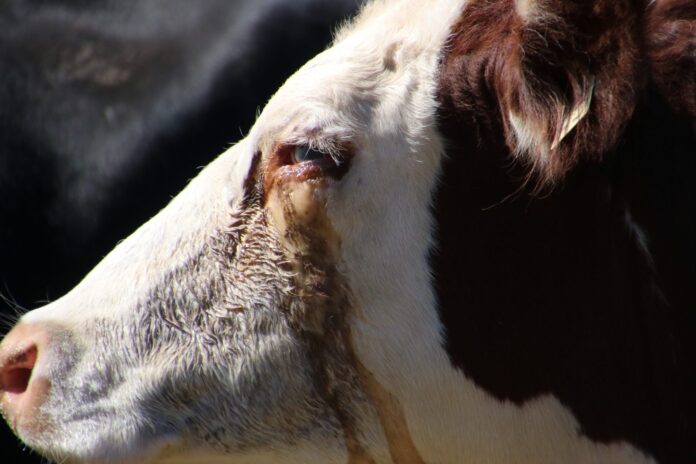AUBURN UNIVERSITY, Ala. – Pinkeye is a well-known bacterial infection that cattle producers watch for each year. The number of cases often increase during the summer and into the fall. The bacterium Moraxella bovis is most associated with pinkeye infections. However, an Alabama Cooperative Extension System veterinarian said there are other viruses and bacteria that labs are connecting with the disease.
Symptoms and transmission
Pinkeye first presents itself as excessive watering in one or both eyes of the animal. It can affect cattle of all breeds and ages. As the disease progresses, it causes conjunctivitis—which is an inflammation of the eyelid—and corneal ulcers. The cattle will also exhibit sensitivity to light.
Soren Rodning, an Alabama Extension animal sciences specialist, said one reason why producers typically see more cases of pinkeye in the summer and fall is because of the creatures that transmit the disease.
“Face flies play a major role in transmission of the organisms typically associated with pinkeye,” Rodning said. “So, for producers that have fly problems, it can lead to pinkeye problems.”
People have historically linked pinkeye to the Moraxella bovis bacterium. However, Rodning said diagnostic laboratories have more recently identified viruses and other bacteria that cause similar symptoms.
“The virus, bovine herpesvirus, and the bacteria, Moraxella bovoculi, Mycoplasma bovis and Mycoplasma bovoculi, are all examples of organisms that are now linked to pinkeye,” Rodning said.
Prevention
While none of the recently identified organisms are new, Rodning said the link to pinkeye could cause issues related to vaccine use for disease prevention.
“Most commercially available pinkeye vaccines only provide protection against certain isolates of Moraxella bovis,” Rodning said. “A smaller number of commercially available vaccines provide protection against Moraxella bovoculi.”
If pinkeye is a common problem, Rodning recommends that producers consider working with their veterinarian to implement an autogenous pinkeye vaccine into their herd management plan. An autogenous vaccine is a custom-made vaccine that targets a particular infection or disease. In this case, a veterinarian can help producers develop an autogenous vaccine that provides protection against multiple organisms associated with pinkeye.
Treatment
When it comes to treating infections, time is of the essence. Untreated cases—or instances where treatment is delayed—can lead to permanent blindness in cattle.
“Producers can successfully treat pinkeye, but they must begin treatment early to reduce the chance of permanent damage to the eye,” Rodning said. “There are multiple products that are approved to treat pinkeye in cattle. Contact your veterinarian for specific treatment recommendations in your area.”
Changes to antibiotic access
In January 2017, the Food and Drug Administration issued the Guidance for the Industry #213 directive. This significantly changed the way people in the livestock industry use medically important antibiotics administered via feed or minerals. One of the drugs affected by this directive was chlortetracycline.
“Prior to 2017, chlortetracycline was available over the counter and was more commonly administered via feed or mineral mixes in the Southeast for control of anaplasmosis during the summer and fall,” Rodning said. “However, while it was and is not labeled for control of pinkeye, a secondary effect of the drug is that it would help control pinkeye in addition to anaplasmosis.”
In an effort to slow the development and spread of antibiotic-resistant bacteria, the 2017 FDA directive removed the over-the-counter option for most antibiotics. This also required producers to have a Veterinary Feed Directive from a licensed veterinarian to purchase the antibiotics administered in feed or minerals.
To continue the effort to slow the development of antibiotic-resistant bacteria, Rodning said a new FDA directive (Guidance for the Industry #263) will remove most over-the-counter antibiotic options.
“The FDA’s new directive will take effect on June 11,” Rodning said. “This means over-the-counter injectable antibiotics used in livestock will no longer be available without a prescription from a licensed veterinarian. This includes the antibiotic, oxytetracycline. Historically, injectable oxytetracycline has commonly been used to treat clinical cases of pinkeye.”
This change means that producers using injectable oxytetracycline will have to change their methods of access. While this is a change for some producers, a lot of other antibiotics commonly used to treat pinkeye have always required a prescription. So, this directive won’t affect producers using those products.
More information
For more information on the FDA’s directive related to over-the-counter antibiotics, read Rodning’s Extension Brief Over-the-Counter Option for Livestock Antibiotics is Going Away. More information on pinkeye is in the Alabama Extension publication, Pinkeye in Cattle, available at www.aces.edu.





















